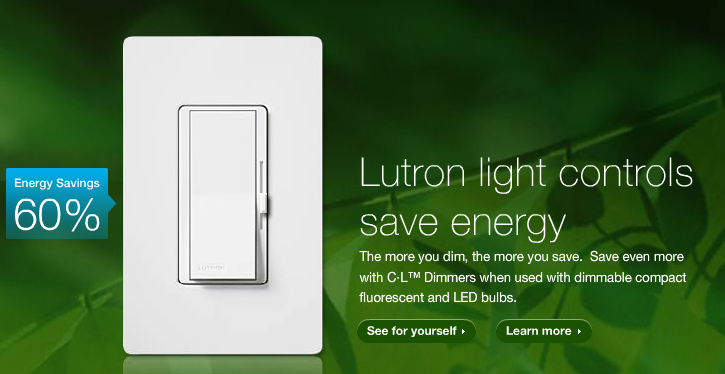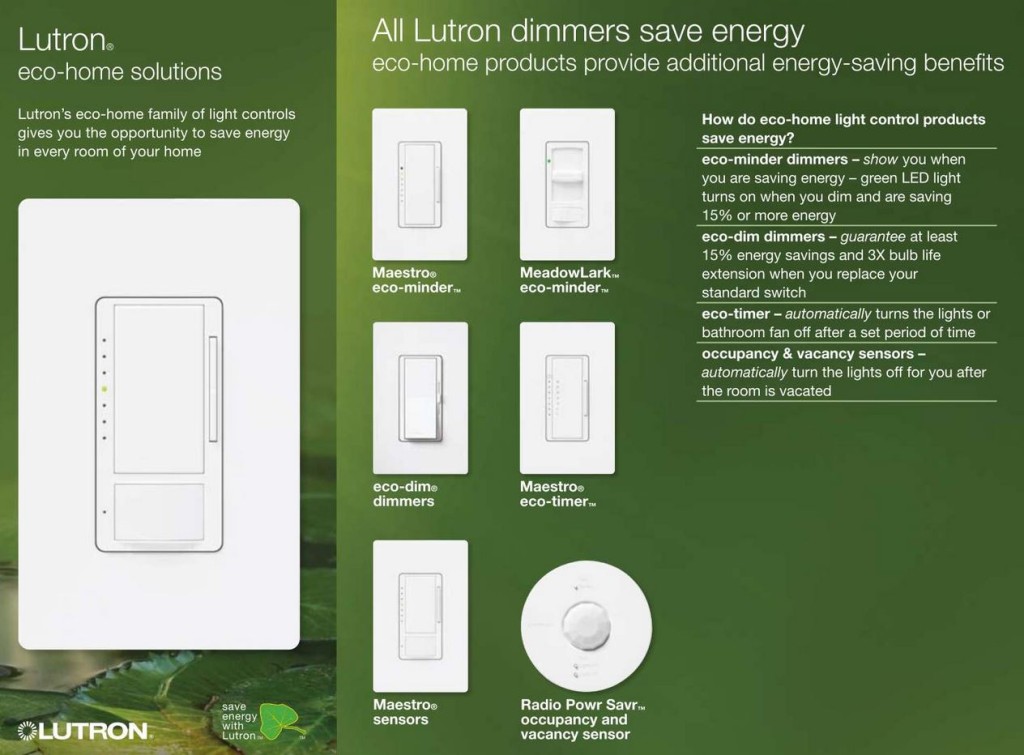- By Clarissa Allison | May 8th, 2015
Dimmer switches may not be the first item on your list when you conjure dreams of remodeling and decorating your home or business. Yet lighting is ever-present and it’s atmosphere and usefulness are important as it dictates what you can and cannot do, affects your mood and can literally transform your environment for the better or worse.
People often need to use rooms for multiple purposes, and these different functions require varying amounts of light. Bring on the dimmer switch, a handy electrical component that lets you adjust light levels from nearly dark to fully lit by simply turning a knob or sliding a lever. Residential lighting accounts for nearly 15 percent of the average American home’s electricity costs. Dimmer switches are one way to help reduce your energy consumption without sacrificing comfort. Although dimmers are known to help create soft mood lighting, they also work to help manage efficiency, and ultimately lower your utility bills.
Let’s explore these everyday yet often overlooked devices to find out how they control our fixtures. Surprisingly, modern dimmer switches work in a totally unexpected way.
Joel Spira, founder, chairman, and director of research for Lutron Electronics Inc., passed away last month at the age of 88. Spira founded the Pennsylvania-based company in 1961 with his wife, Ruth, and is best known for inventing the dimmer switch, a lighting element that has become an ubiquitous accessory in homes and businesses worldwide. Spira brought the light-dimmer switch to households across the nation and transformed Lutron Electronics into a leading manufacturer of lighting controls.
What Dimmer Switches Do
Light fixtures use a certain amount of electricity to produce light, but dimmer switches put you in control of how much electricity your light fixtures use. They replace standard light switches, which only turn fixtures on and off; dimmers usually operate with a dial or sliding bar control. Adjusting the control adjusts the wattage output, resulting in more or less electricity and light as you need it. Although there are helpful online tutorials to help you install your own dimmer switch, if you are not familiar with electrical work, it is wise to hire a licensed electrician to install dimmer switches for your own safety.
Energy Savings
Although the amount of energy savings can vary depending on how much you dim the lights, how often they are dimmed and which type of bulbs you choose, energy savings using compact fluorescent light (CFL) bulbs mirrors the level of reduction. This means that lowering the lights by 15 percent results in a 15-percent energy savings during the time the dimmer is used. Upgrading to high-efficiency light fixtures with energy reducing light bulbs results in more savings than installing dimmer switches to operate ordinary fixtures.
You Can Use Dimmable Bulbs, Too
Run of the mill “old school” incandescent light bulbs lose their efficiency the more they are dimmed, but the life of the bulb and the fixture may increase. It is not recommended, however, to dim a regular incandescent bulb. By now, most people know that they should replace ordinary incandescent light bulbs with efficient compact fluorescent light bulbs, or CFLs, to help save energy whenever possible. Using CFLs can result in a savings of $30 or more over the life of the bulb in a light fixture even without dimmers; so it’s no surprise using dimmers yields additional savings! However, special dimmable CFLs are required for use with dimmers — read packaging carefully.
Best Placement
To obtain the most benefit from installing dimmer switches, place them in rooms where your needs fluctuate. The average wattage of permanently installed lighting is often higher in master bathrooms, for instance. Below that, average wattage rates as followed: 250 watts for kitchens, 235 watts for dining rooms, 207 watts for hallways, 201 watts for living rooms, 190 watts for secondary bathrooms and 107 watts for master bedrooms. Each of these areas is a candidate for energy-saving dimmer switches because they don’t always require the brightest possible light.
How Do They Work?
A light dimmer works by essentially “removing” parts from AC voltage. This allows only parts of the waveform to pass to the lamp. The brightness of the lamp is determined by the power transferred to it, so the more the waveform is chopped, the more it dims.
Mains power is comprised of an alternating current that flows in one direction and then in the other, along the cable, at the rate of 50 or 60 cycles per second (known as Hertz). The value 50 or 60Hz is dependent on the countries power system. The current alternates back and forth changing direction at the zero point. If you saw this waveform it would appear as a stretched “S” shape on its side ~. Draw a line through the middle of the “S” and this is what is called the Zero Crossing Point. At this instant in time no current is flowing in either direction. This is the point at which a dimmer is electronically synchronized to turn the power ON or OFF. By chopping the waveform at the Zero Crossing Point, smooth dimming will be achieved without the lamp flickering. This turning on and off of the power device occurs every time the mains crossing point is reached (half phase), 100 or 120 times per second.
Why Is My Dimmer Buzzing?
When bulbs are at full brightness, the triac turns on most of the AC wave cycle. When a lamp is dimmed, the triac effectively switches the lamp on and off 120 times per second. If the filament in the bulb is not rigidly mounted, the magnetic field induced by the rapid rise in current can cause it to vibrate – resulting in an audible buzz. The noise is greatest at about the 50% dim level since the triac is going from 0 to 120 volts almost instantaneously (from zero to the peak of a sine wave). Even at full on, the dimmer’s triac will “chop” out the first ~1.1ms of each half-sine wave.
Sometimes the noise comes from the dimmer itself. Buzzing is more likely to occur when the total wattage controlled by the dimmer is near the dimmer’s rated maximum. An entry-level 500-watt dimmer may produce more buzz on a 400-watt load than would a 600 or 1000-watt dimmer. A filter with more copper turns will yield better performance.
Better quality dimmers may help to reduce noise as most higher end dimmers include an internal component called an LC filter which helps smooth out the starts and stops of the triac. Think of it like a spring which absorbs some of the jolts of voltage as electricity is turned on and off. Consider using one of the Lutron dimmers available on our website which are made with high quality components that will reduce the buzzing effect, but also can be remotely controlled, either from another switch, handheld remote or via an app on your smartphone!
Feel free to browse our great selection of Lutron Electronics dimmer switches available for purchase on LouieLighting.com, and don’t hesitate to call us toll free at 1877 385 2104 or email info@louielighting.com for help selecting the right dimmers for your next project.
The Louie Lighting Team wishes you and yours a safe and happy weekend!






Frankly I think that's abstuloely good stuff.